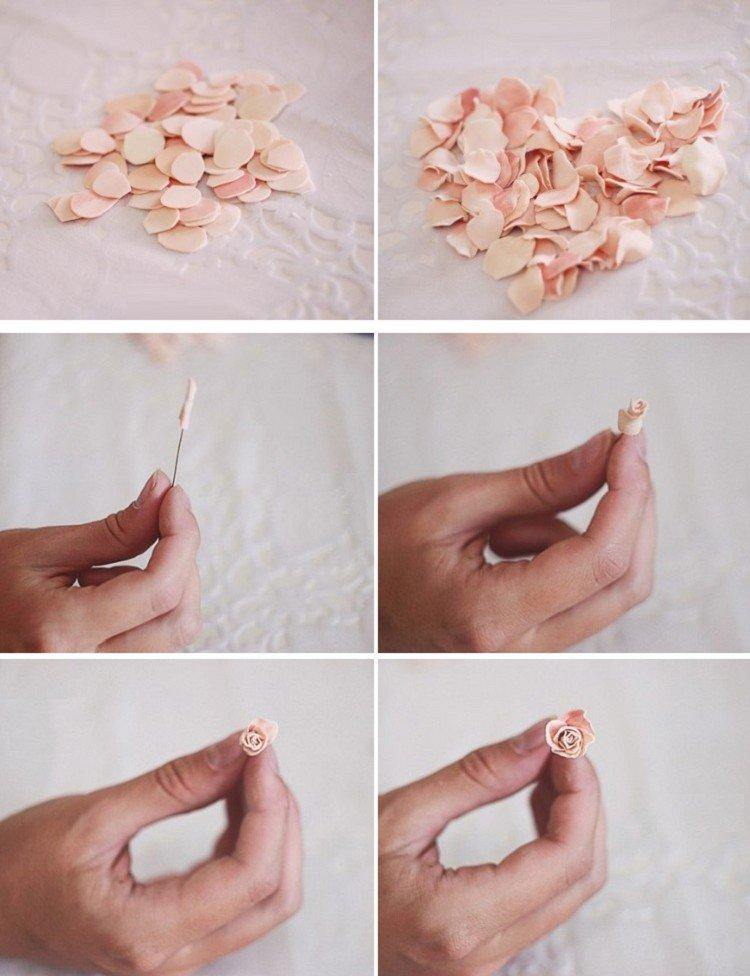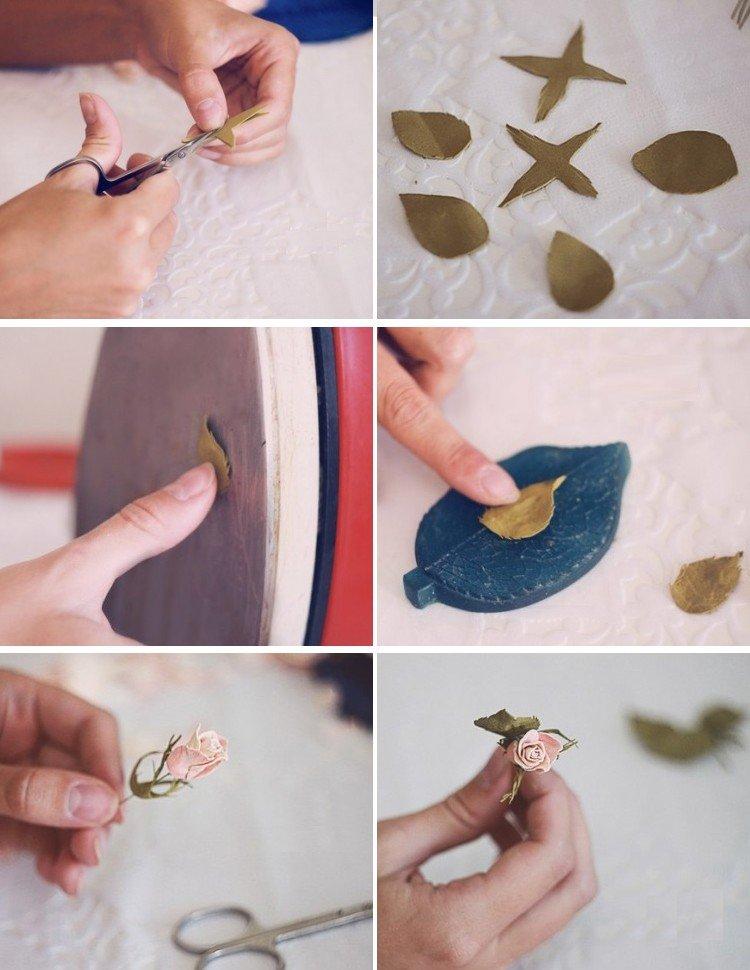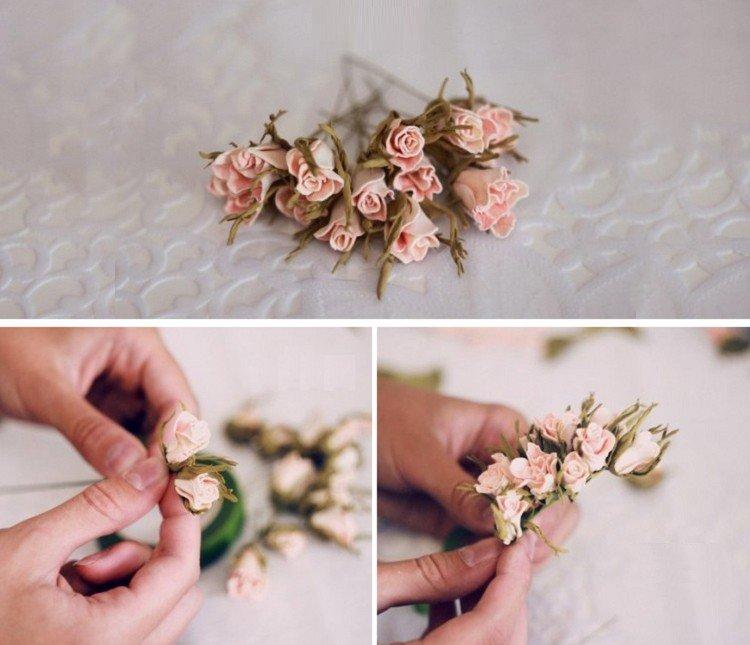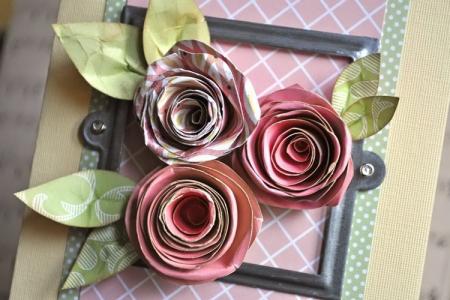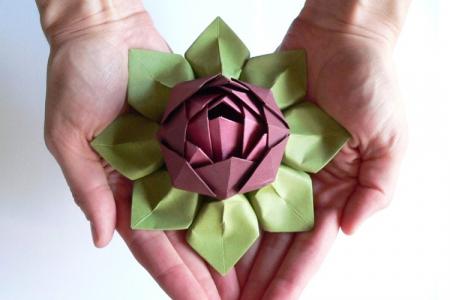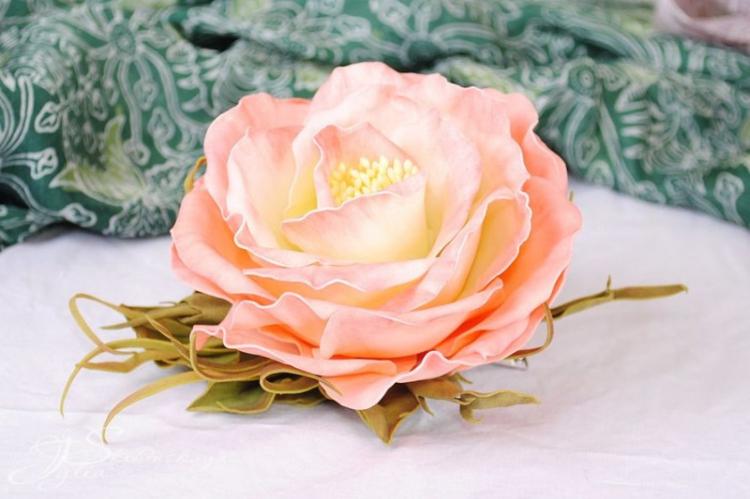
Foamiran or plastic suede is a material loved by all needlewomen. It forms easily when heated and then retains this shape. It is also easy to paint, and looks realistic due to the texture of a dense sponge. We have collected 6 step-by-step master classes on how to make roses from foamiran with your own hands. Just look at this beauty!
1. Rose from individual petals
You will need a leaf of red and green foamiran, green floral tape, wire, glue gun, lighter and paints or pastels. Cut 15 to 25 small red rectangles from foamiran about 3x4 cm in size. Fold them in half, round the edges and form curved petals, heating them near the iron for 3-5 seconds at 100 degrees.
Knead and stretch each heated workpiece well so that it becomes thinner and softer. Make concave boats, filling in the edges, and squeeze a small fold at the base. Fix this fold with tweezers and warm it up with a lighter - this will be the place of attachment to the stem.
Take a foam ball or egg for the middle, or roll one out of foil. Insert the wire inside and begin to wrap the blank with petals until the rose is the right size. In the process, continue to shape the petals with your hands, depending on the degree of your bud opening.
When you're done, wrap the stem wire with a green ribbon or a narrow strip of foamiran. Cut out the green leaves and flower garden glue, which can then be tinted with pastels. If you have a mold or a stamp, add texture to all the details, and knead it in the same way at the iron. All that remains is to add the rose to the glue gun.
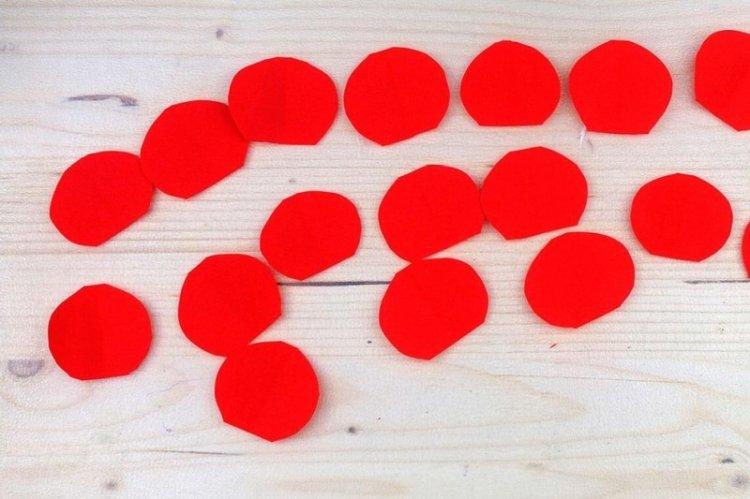
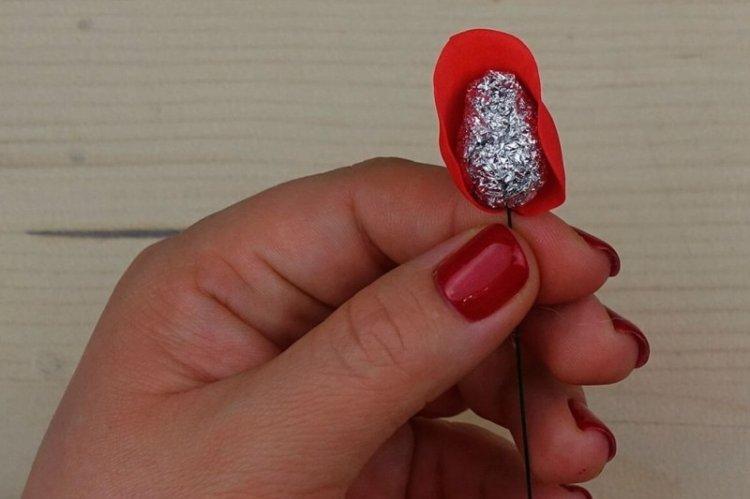
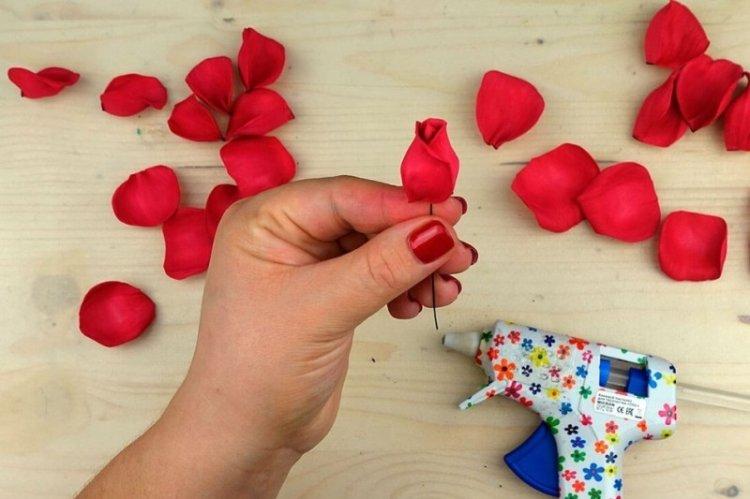
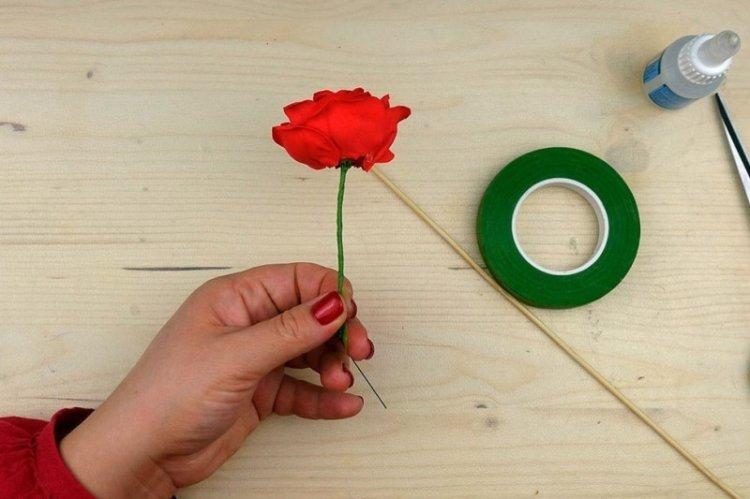

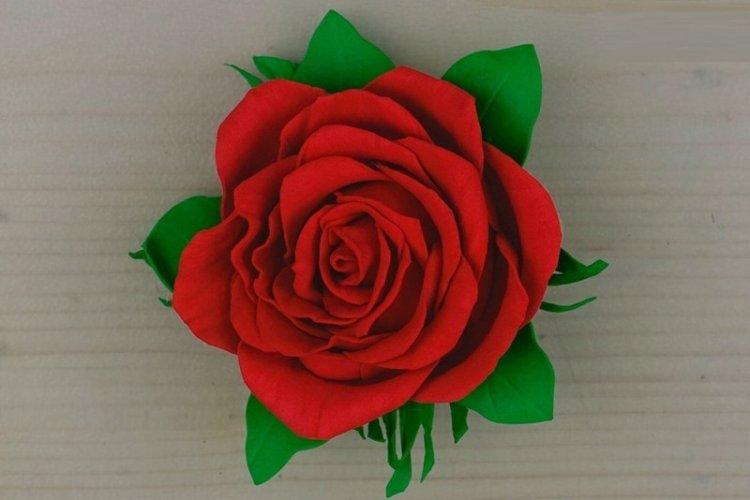
2. Lush textured rose
Transfer the templates to cardboard, and then to pastel foamiran: in total, you will have 20 large petals (5x6), 7 small ones (4x4), 5 leaves (5x6) and gluing (7x7). You can make a couple more spare parts in case something breaks in the process.
Circle all the blanks with a toothpick and carefully cut with sharp scissors. Tint the light petals with acrylic paints using a sponge or grated pastels. For the base, make a drop-egg from foil or polymer clay, and insert the stem wire into it.
Alternately apply each petal to the iron for a couple of seconds and immediately fold them into an accordion, and then twist them into a spiral to the middle. Due to this, the outer edges of the petals will turn out to be delicate and realistic. Unfold the petal, form a boat, and straighten and stretch the outer edge a little more with your fingers.
In the same way, heat the leaves and sepal, give them a shape and, if any, interrupt the texture from the molding. Begin to wrap the plastic drop with petals from smallest to largest. Fasten them with a glue gun and immediately trim off the protruding edges from the bottom.
The first layer must be dense - this is the bud. But put the next ones more freely, but so that each next petal covers the previous one to the middle. Cut the last rows at once and glue at two points directly at the base - this way they will turn out to be the most open.
Secure the base with a large drop of glue, wait until dry, and wrap in a sepal. Glue the leaves to a wire wrapped in the same green foamiran and collect them on the stem of the rose.
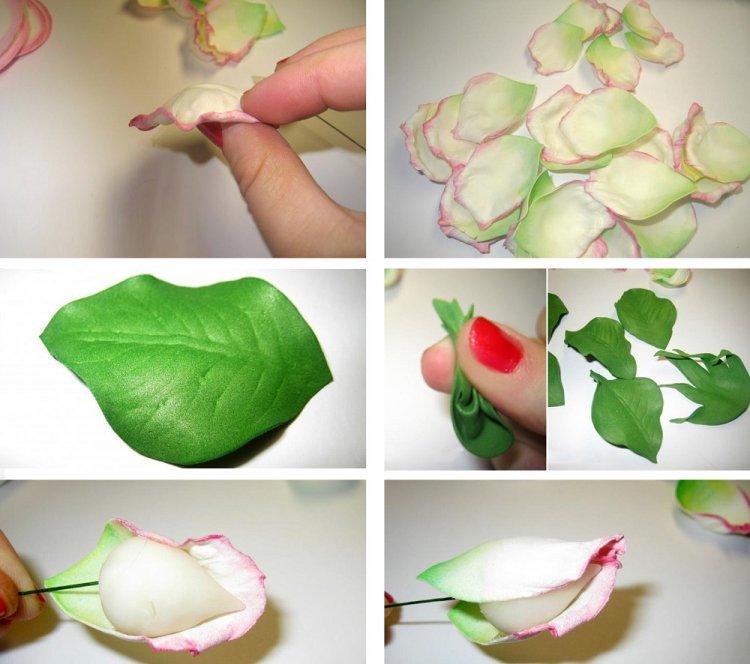
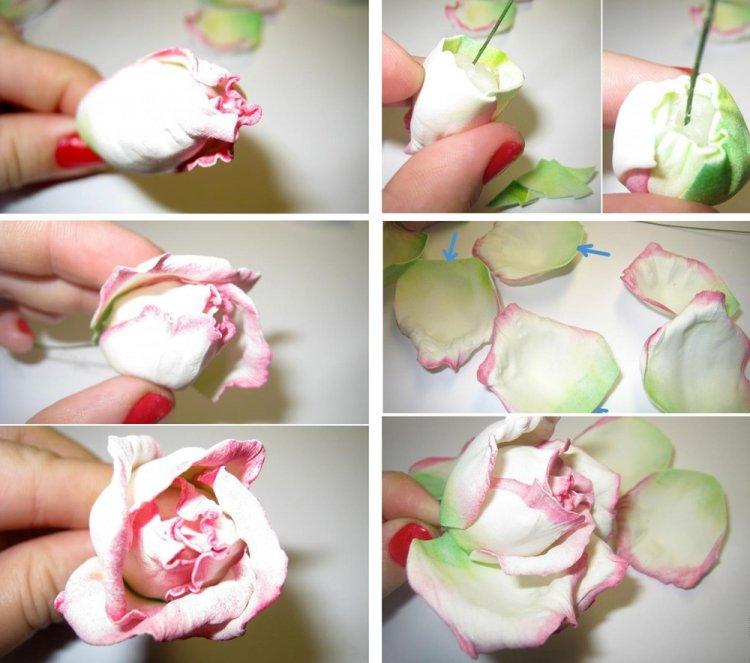
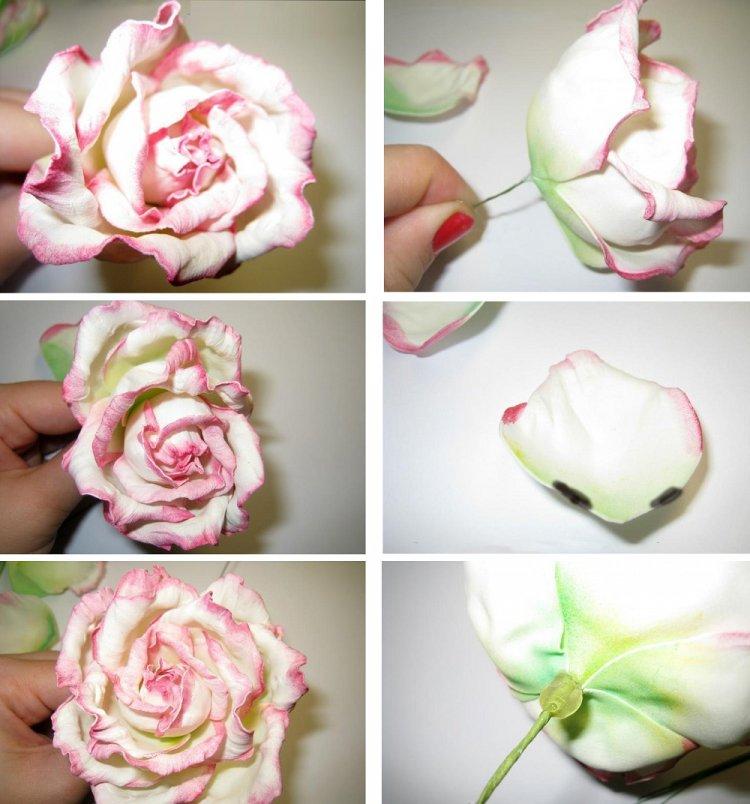
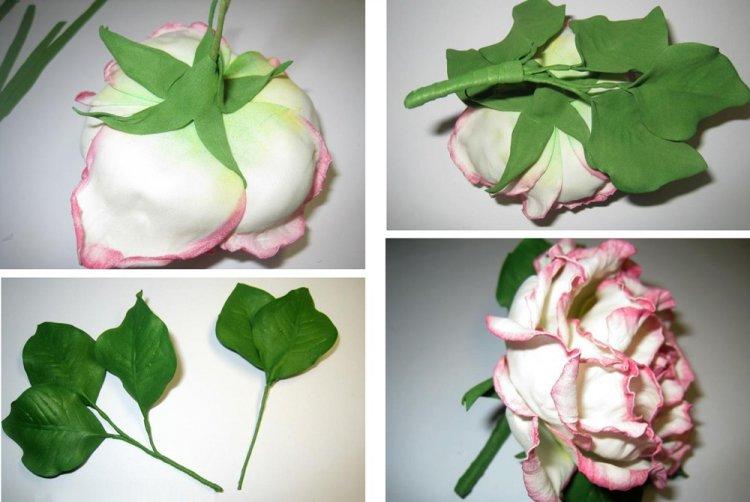
3. Foamiran rosebud
If you are making a whole bouquet or wreath, add some unopened buds to it. It is the easiest to make - you only need 5 petals and 5 sepal droplets. Attach each petal to the iron and immediately form a boat out of it. First give the sepals a shape by means of cuts along the entire length, and then also make them concave.
Make a drop of foil or polymer clay and place it on the wire with a loop. Wrap the petals tightly around the droplet, forming a cone - as in the photo.The next circle of petals does not fit so tightly - and all that remains is to glue the sepals on top.
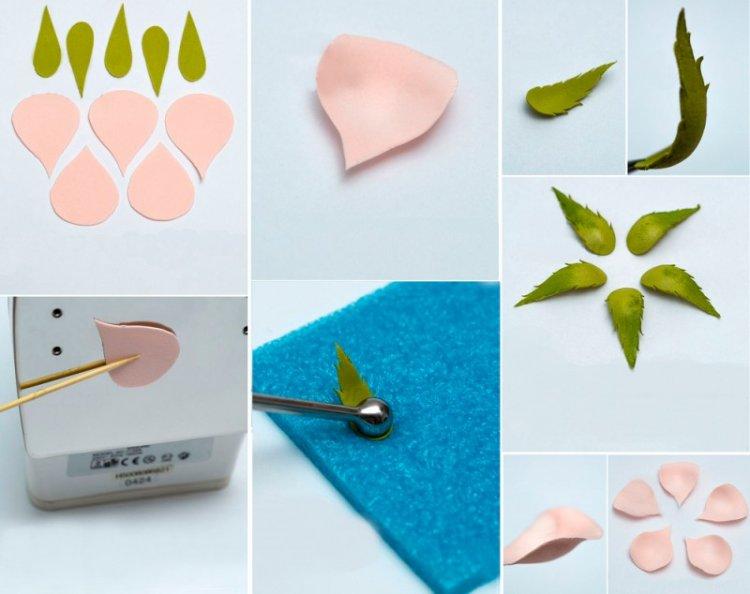
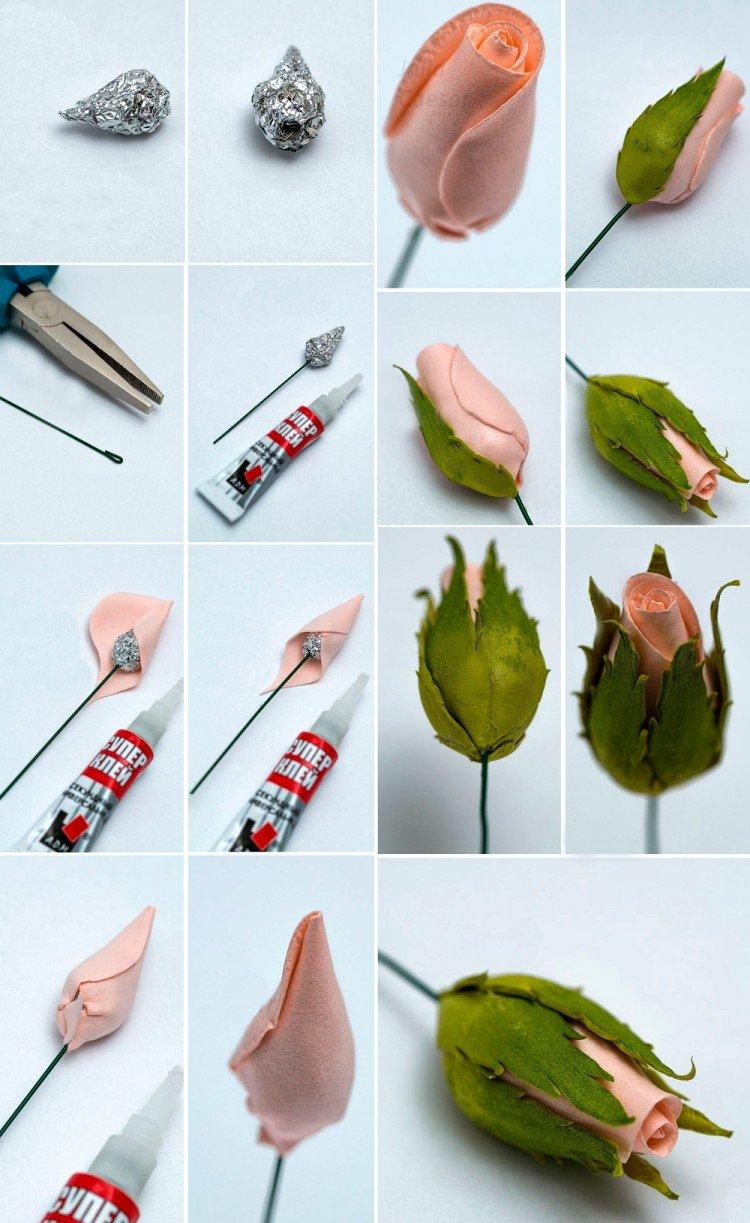
4. Rose from whole inflorescences
This method is a little faster than forming a rose from individual petals. Here you immediately use whole inflorescences, so less details are needed. For work, take white and green foamiran, pastel acrylic paints, wire, glue, foil or a foam ball for the middle.
Transfer all three rim patterns (2-3 parts each) to a white sheet, and gluing (1 part) to a green sheet. It is most convenient to trace the templates with a toothpick - a neat and noticeable mark remains from it. At the end of a piece of wire, make a loop and attach a foam ball about 1.5 cm in diameter.
The petals are tinted with acrylic paint using a sponge or sponge. Although you can use regular pastels if there is a suitable shade. Cut all the corolla-inflorescences into petals, a little short of the middle - you will wrap them around the ball.
Form the petals gradually, bringing one at a time to the iron and quickly pressing in the middle with your fingers. At the same time, stretch the details of medium size a little more to get a voluminous "boat". Form a glue, wrapping all the tips, and take care of the leaves. To interrupt the texture of real leaves on them, there are ready-made molds (stamps) in handicraft stores.
Put the first small whisk on the wire and wrap the petals around the ball. Lay the petals alternately from opposite ones and fix each with a glue gun. Using the same principle, put on all the following corollas, in the process, bending and forming the petals around the bud. Cut the wire, glue the glue and the leaves - a beautiful foamiran rose is ready!
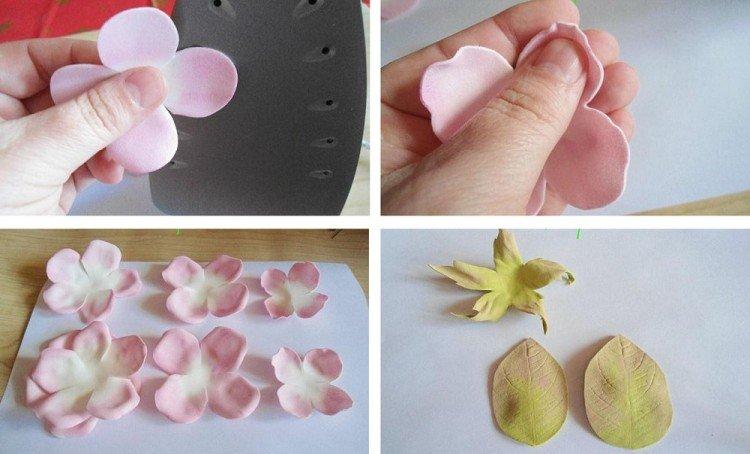
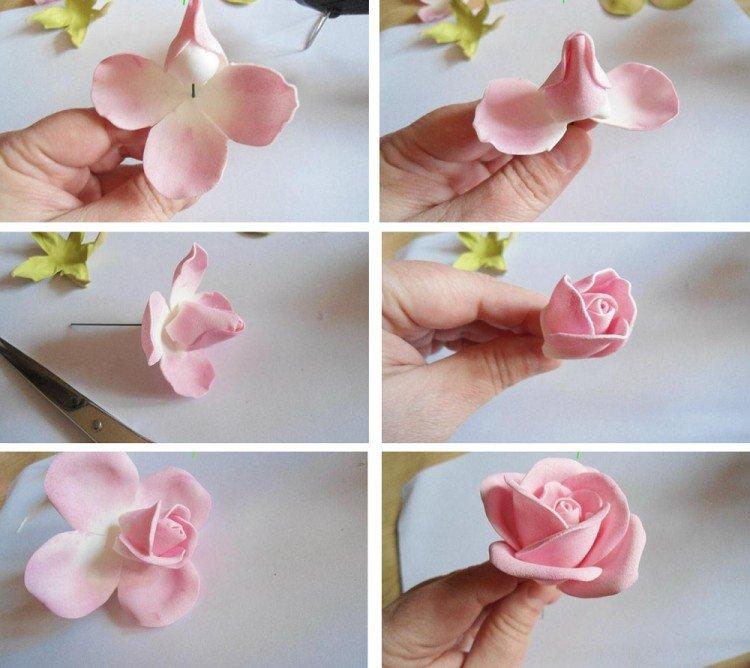
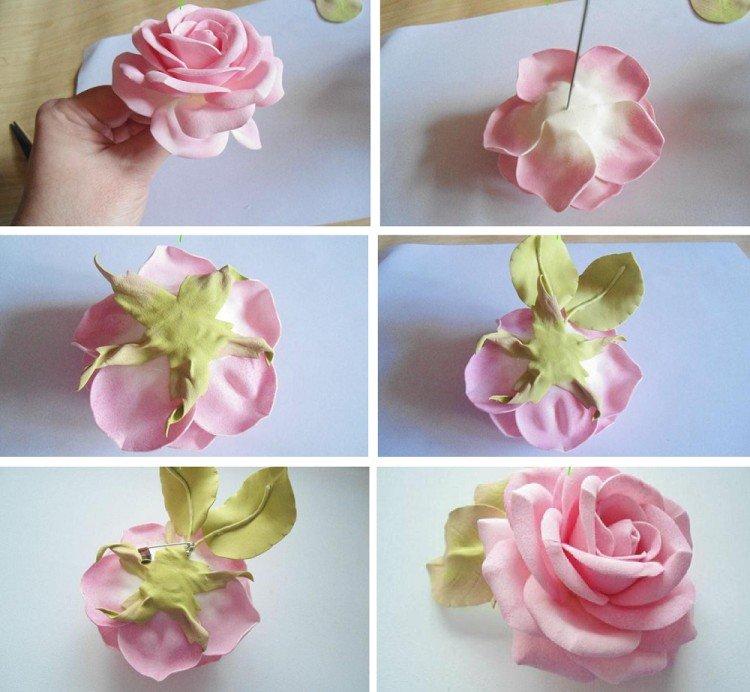
5. Lush peony rose
To make the flower even more expressive, take foamiran 2-3 different close shades for the petals. Cut out all the blanks from the diagram - in the same quantity and proportions. The shape does not have to be perfect - it will only add realism.
It is convenient to warm up small petals and form them with a regular loop or any other similar tool. For large ones, a ball of a suitable diameter or a larger loop will do. But it is better to form the sepal and large petals by hand, gently twisting and stretching.
Take 4 pieces of wire and make a loop on each for the middle. Glue 3 small petals on each, then 4 more petals more. Move the next 3 petals down a little so that the blanks look like in the photo.
Twist the parts together in pairs and connect them together in one large volumetric middle. Begin to glue all large petals from below, so that each next one overlaps the previous one by at least a third, and at the very end add a sepal. Correct the shape of the middle with a toothpick or any other thin tool.
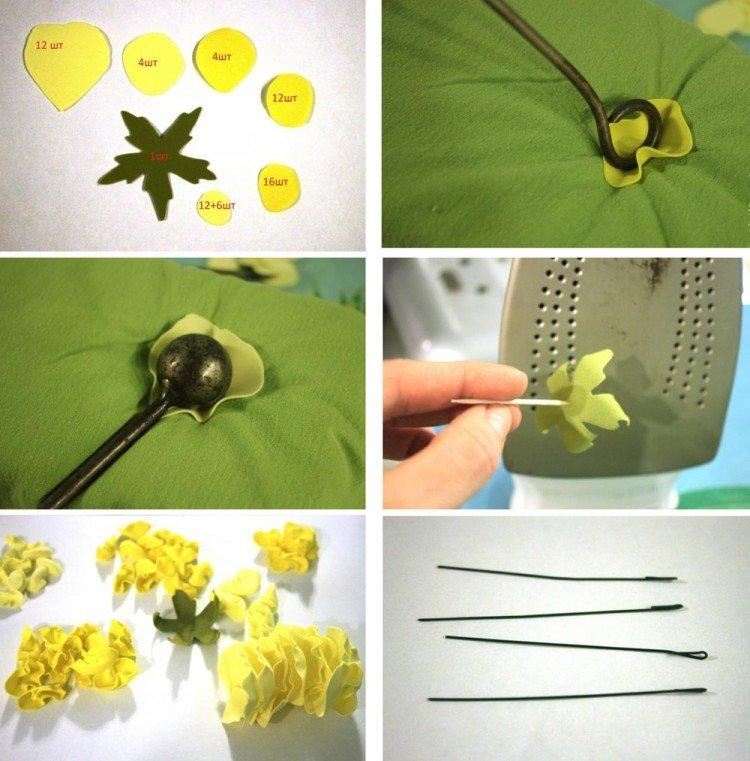
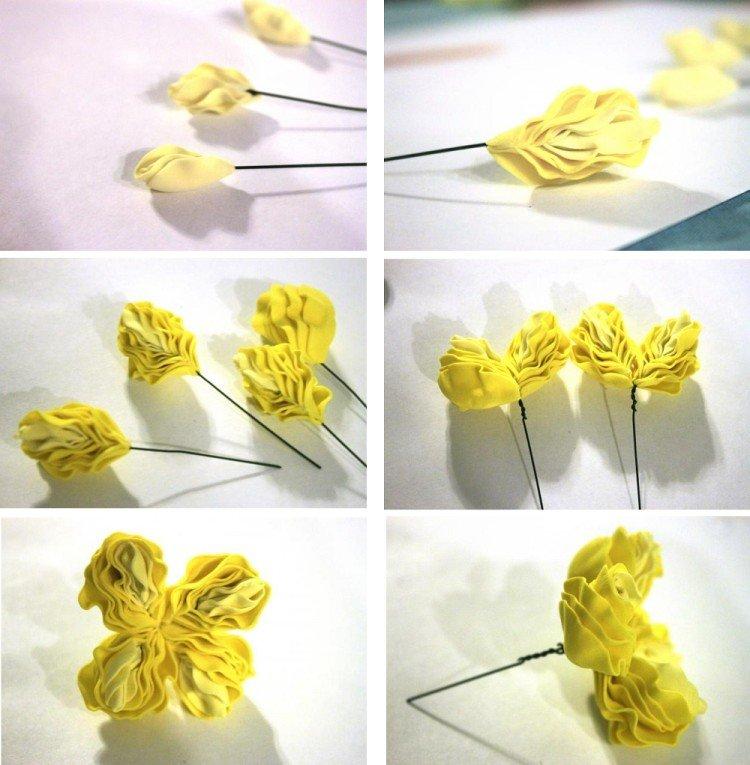
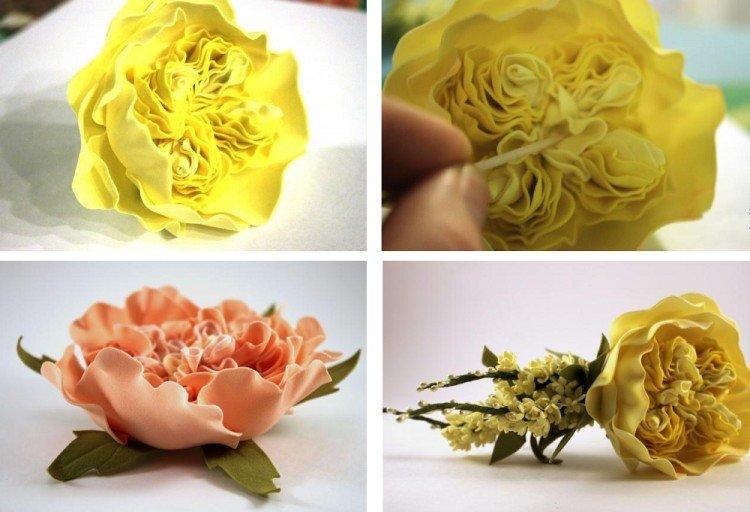
6. Tea roses for decoration
Small foamiran roses are ideal for decorating wreaths, hoops and hairpins. Choose foamiran of one or more adjacent shades and cut many small, rounded petals about 1.5 cm in size.You will need 6 to 10 for one flower - so calculate the number in advance.
Apply each petal to the sole of the iron for a couple of seconds and twist immediately. Then you need to straighten them and shape them with your fingers: bend them a little in the middle and stretch the edges. For the frame, you will need a thin wire with a loop at the end - according to the number of flowers.
Begin to wrap each wire tightly with petals in a spiral and form buds. Glue each next circle not so tightly and bend the edges by hand, with a toothpick or tweezers. You can then add small leaves and sepals if necessary.
